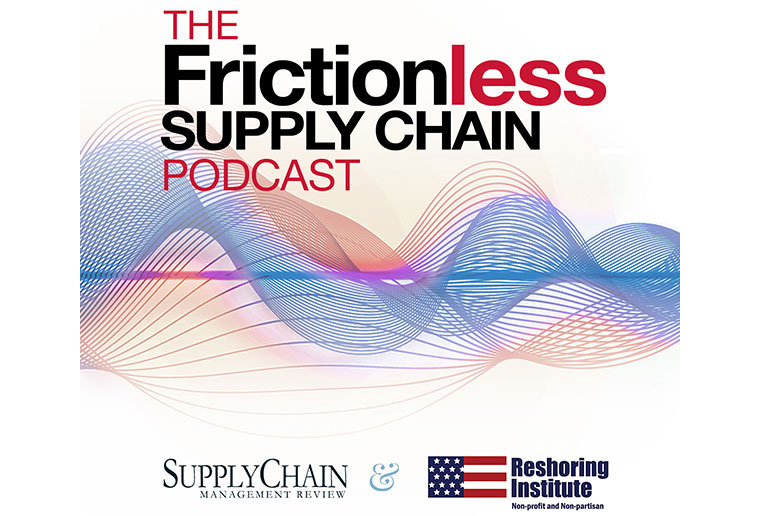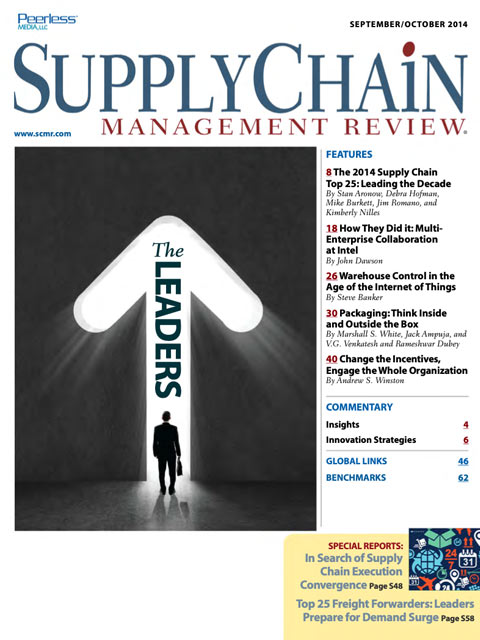Sorry, but your login has failed. Please recheck your login information and resubmit. If your subscription has expired, renew here.
September-October 2014
2014 marks the 10 year anniversary of the Gartner Supply Chain Top 25 ranking. This year we have a diverse set of large, global companies with mature, demand-driven supply chains. There are lessons to be learned from these supply chain leaders, many of whom have led their industries over the past decade. Browse this issue archive.Need Help? Contact customer service 847-559-7581 More options
Many organizations seek to benefit from information transparency, especially in their supply chains. One approach organizations have taken to achieve this goal is to share real-time, electronic demand and inventory levels within the enterprise and with external partners. The belief is that making this information available will enable organizations to shorten order processing times through improved inventory levels and deliver a more accurate picture of customer needs.
While it may seem counterintuitive, our research indicates that organizations that focus on data sharing without also addressing their underlying processes sometimes end up with less efficient supply chains than other organizations. In other words, while access to real-time demand and inventory data gives a more accurate picture of customer needs, information alone is not enough.
What then is the current state of the market?
Data from APQC’s Open Standards Benchmarking in logistics indicates that a slight majority of organizations (59 percent) have adopted the sharing of real-time, electronic demand and inventory data within the enterprise and with external partners ( Of organizations that do make this data available, 26 percent have done so extensively.
 |
This complete article is available to subscribers
only. Click on Log In Now at the top of this article for full access. Or, Start your PLUS+ subscription for instant access. |
Not ready to subscribe, but need this article?
Buy the complete article now. Only $20.00. Instant PDF Download.
Access the complete issue of Supply Chain Management Review magazine featuring
this article including every word, chart and table exactly as it appeared in the magazine.
SC
MR
Sorry, but your login has failed. Please recheck your login information and resubmit. If your subscription has expired, renew here.
September-October 2014
2014 marks the 10 year anniversary of the Gartner Supply Chain Top 25 ranking. This year we have a diverse set of large, global companies with mature, demand-driven supply chains. There are lessons to be… Browse this issue archive. Access your online digital edition. Download a PDF file of the September-October 2014 issue.
 |
Download Article PDF |
Many organizations seek to benefit from information transparency, especially in their supply chains. One approach organizations have taken to achieve this goal is to share real-time, electronic demand and inventory levels within the enterprise and with external partners. The belief is that making this information available will enable organizations to shorten order processing times through improved inventory levels and deliver a more accurate picture of customer needs.
While it may seem counterintuitive, our research indicates that organizations that focus on data sharing without also addressing their underlying processes sometimes end up with less efficient supply chains than other organizations. In other words, while access to real-time demand and inventory data gives a more accurate picture of customer needs, information alone is not enough.
What then is the current state of the market?
Data from APQC’s Open Standards Benchmarking in logistics indicates that a slight majority of organizations (59 percent) have adopted the sharing of real-time, electronic demand and inventory data within the enterprise and with external partners ( Of organizations that do make this data available, 26 percent have done so extensively.
 |
SUBSCRIBERS: Click here to download PDF of the full article. |
SC
MR

Latest Supply Chain News
- Tips for CIOs to overcome technology talent acquisition troubles
- There is still work to do to achieve supply chain stability
- Blooming success: The vital role of S&OE in nurturing global supply chains
- Supply chain salaries, job satisfaction on the rise
- How one small part held up shipments of thousands of autos
- More News
Latest Podcast

 Explore
Explore
Latest Supply Chain News
- Tips for CIOs to overcome technology talent acquisition troubles
- There is still work to do to achieve supply chain stability
- Blooming success: The vital role of S&OE in nurturing global supply chains
- Supply chain salaries, job satisfaction on the rise
- How one small part held up shipments of thousands of autos
- Investor expectations influencing supply chain decision-making
- More latest news
Latest Resources

Subscribe

Supply Chain Management Review delivers the best industry content.

Editors’ Picks





